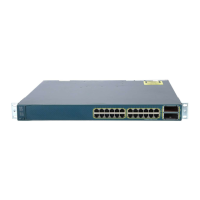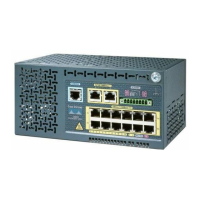11-19
Catalyst 3750 Switch Software Configuration Guide
78-16180-02
Chapter 11 Configuring Interface Characteristics
Configuring Ethernet Interfaces
Configuring Power over Ethernet on an Interface
The switch supports both the Cisco pre-standard PoE method and the IEEE 802.3af PoE standard. The
switches automatically supply power to connected pre-standard powered devices (such as Cisco IP
Phones and Cisco Aironet access points) and IEEE 802.3af-compliant powered devices if the switch
senses that there is no power on the circuit.
On a 24-port PoE switch, each 10/100 port provides 15.4 W of power. On a 48-port PoE switch, any 24 of
the 48 10/100 ports provide 15.4 W of power, or any combination of ports provide an average of 7.7 W
of power at the same time, up to a maximum switch power output of 370 W.
A powered device can receive redundant power when it is connected to a PoE switch port and to an AC
power source. If a device being powered by the switch is then connected to wall power, the switch might
continue to power the device. The switch continues to report that it is still powering the device whether
the device is being powered by the switch or receiving power from an AC power source.
The switch detects the power required by any new device that is connected and decides whether the
device requires more power than is currently available. If the switch cannot supply the required power,
the new device is not powered, and the switch provides this information in the CLI show command
messages, by sending a syslog error message, and in LED displays. Refer to the hardware installation
guide for LED information.
The switch automatically maintains a power budget, monitors and tracks requests for power, and grants
power only when it is available. When a PoE-capable interface is in the no-shutdown state with PoE
enabled (the default), and a pre-standard or IEEE-compliant powered device is connected to the
interface, the switch detects when the connected device is not being powered by an AC adaptor. When a
device needing power is detected, the switch determines the device power requirements based on its type
or uses an initial allocation of 15.4 W for power budgeting.
• If enough power is available, the switch grants power, updates the power budget, turns on power to
the interface, and updates the LEDs.
• If granting power would exceed the system power budget, the switch denies power, ensures that
power to the interface is turned off, generates a syslog message, and updates the LEDs. After power
has been denied, the switch periodically rechecks the power budget and continues to attempt to grant
the request for power.
• If enough power is available for all powered devices connected to a switch, power is turned on to all
devices. If there is not enough available PoE, or if a device is disconnected and reconnected while
other devices are waiting for power, devices to be granted or denied power cannot be predetermined.
After power is applied to an interface, the switch uses Cisco Discovery Protocol (CDP) to determine the
power requirement of the connected Cisco PoE (standard and pre-standard) devices, and the switch
adjusts the power budget accordingly. This does not apply to third-party PoE devices. If the switch
detects a fault caused by an undervoltage, overvoltage, overtemperature, oscillator-fault, or short-circuit
condition, it turns off power to the port, generates a syslog message, and updates the power budget and
LEDs.
The PoE feature operates the same whether or not the switch is a stack member. The power budget is
per-switch and independent of any other switch in the stack. Election of a new stack master does not
affect PoE operation. The stack master keeps track of PoE status for all switches and interfaces in the
stack and includes the status in output displays.
